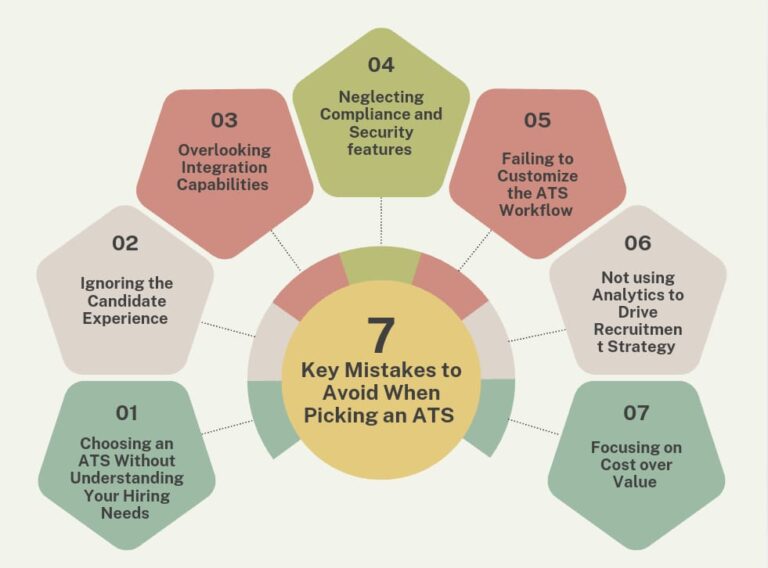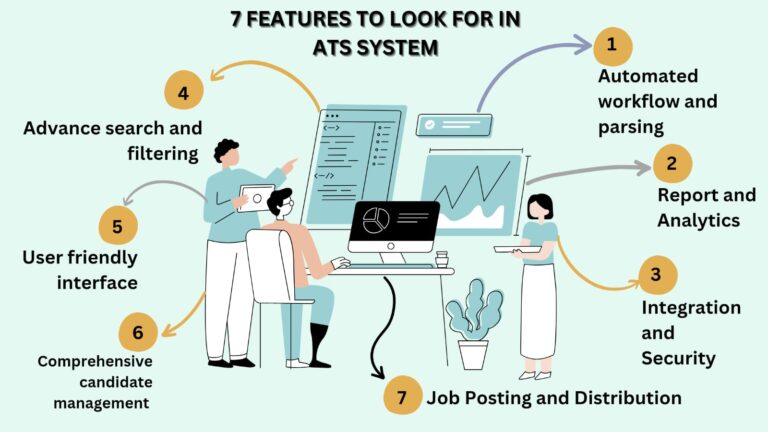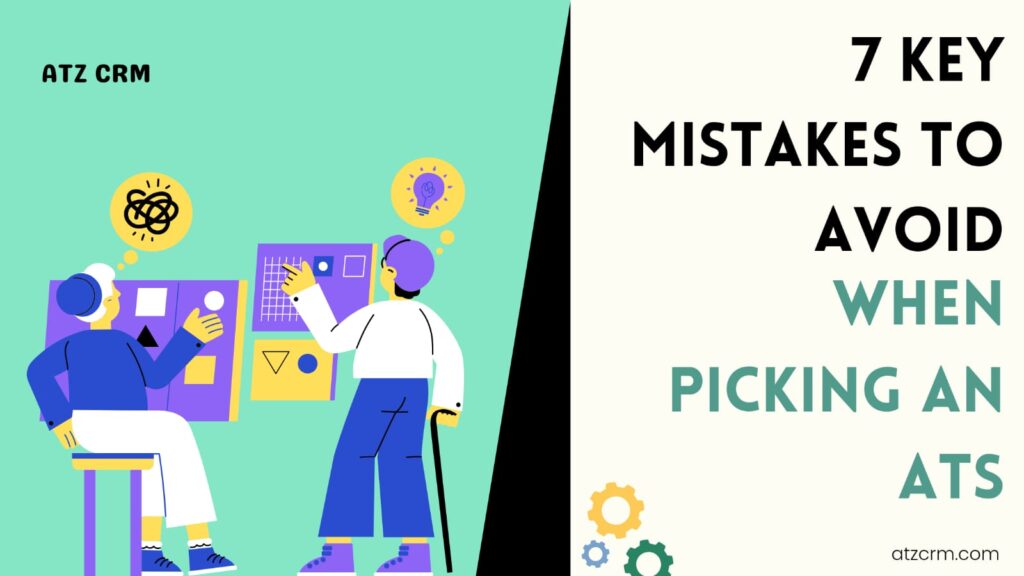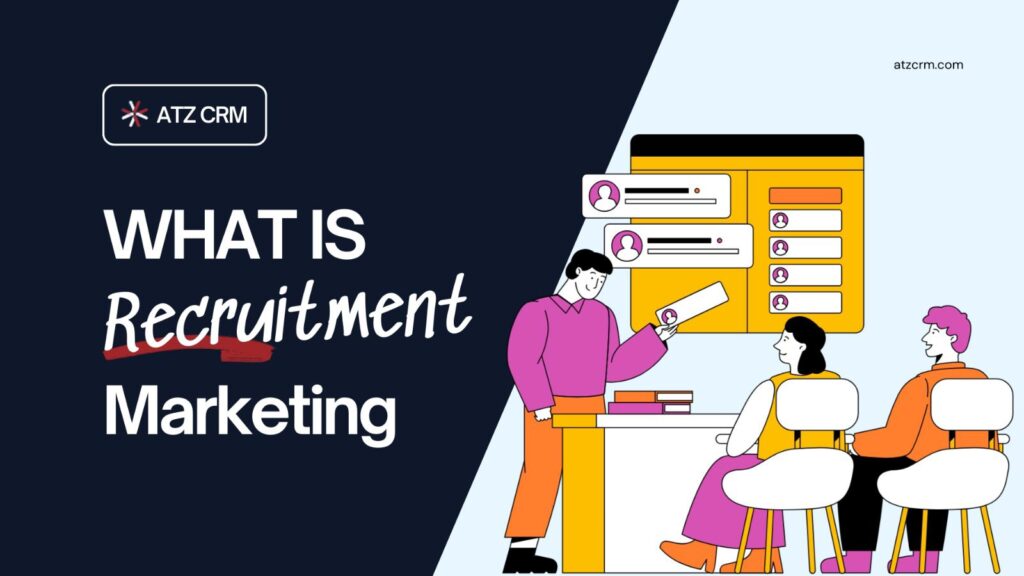Are you in the process of selecting an Applicant Tracking System (ATS) for your recruitment agency? With so many options out there, picking the right ATS can feel like a high-stakes decision—one that impacts hiring efficiency, candidate experience, and your team’s productivity. Choosing the right ATS can transform your recruitment processes by streamlining operations, improving candidate engagement, and enabling data-driven decisions.
Choosing the right Applicant Tracking System (ATS) can significantly improve your recruitment process. However, picking the wrong one can create bottlenecks and frustrations for both hiring teams and candidates.
In this guide, we’ll walk you through seven crucial mistakes to avoid when choosing an ATS, equipping you with actionable insights to make a choice that aligns with your agency’s unique needs and long-term goals.
7 Key Mistakes to Avoid When Picking an ATS

The first and perhaps most common mistake is selecting an ATS without thoroughly understanding your hiring needs. An ATS should enhance your processes—not complicate them. Without a clear understanding, you risk choosing a tool that’s either too basic, lacks key features, or is unnecessarily complex.
For example, a small recruitment agency may benefit most from a straightforward ATS with essential functionalities, such as automated resume parsing and customizable workflows. Large enterprises, on the other hand, may need more sophisticated capabilities, like multi-user access, advanced analytics, and multilingual support to cater to global hiring needs. A small team will find a complex ATS overwhelming, while an enterprise may outgrow a simplistic solution, resulting in added costs.
Best Practices to Avoid This Mistake:
- Create a Requirements Checklist: Identify must-have features like automated resume parsing, collaboration tools, and reporting analytics.
- Consult Your Team: Gather input from recruiters to ensure the ATS aligns with daily workflows.
- Research ATS Flexibility: Opt for platforms that allow custom workflows or feature toggling for different roles.
Explore more in our article on 7 Powerful Resume Parsing Tools for Hiring in 2024.
2. Ignoring the Candidate Experience
An ATS that prioritizes only the recruiter’s perspective is missing half the equation. Candidates increasingly expect streamlined digital interactions, and a clunky or complicated system can lead to high drop-off rates. A poor candidate experience affects your employer brand and could cost you top talent.
Key Features for a Candidate-Centric ATS:
- Mobile-Friendly Applications: With over 50% of job searches conducted on mobile, your ATS must be optimized for mobile use.
- Simple, Intuitive Interface: Keep the application steps concise and user-friendly.
- Personalized Communication: Automated updates—from application acknowledgment to interview scheduling—provide a professional touch that candidates appreciate.
Best Practices to Avoid This Mistake:
- Test the Candidate Journey: Conduct a walkthrough of the application process from a candidate’s perspective.
- Monitor Drop-off Points: Use analytics to find out where candidates may abandon the process.
- Request Candidate Feedback: Use surveys to gather feedback on the application experience.
Read more about enhancing the candidate journey in our post on How to Measure Candidate Experience.
Choosing an ATS that operates in isolation can quickly become a bottleneck. ATS platforms need to integrate seamlessly with other tools like CRM, payroll, and HR systems to avoid data silos, redundancies, and extra manual work.
Examples of Crucial ATS Integrations:
- CRM Integration: Allow recruitment data to link seamlessly with sales and client information, providing a holistic view of interactions.
- Onboarding Tools: Direct integration helps with a smooth transition from candidate to employee.
- Resume Parsing Software: This allows for more efficient data extraction, helping recruiters access candidate information quickly.
Best Practices to Avoid This Mistake:
- Identify Core Systems for Integration: List existing tools that your ATS must work with.
- Check for Open API Access: Choose an ATS that supports API-based integrations for flexibility.
- Consult Vendors on Integration Support: Ask vendors about integration support for a hassle-free implementation.
See our recommendations in 10 Features to Look For In A CRM For Recruitment.
4. Neglecting Compliance and Security Features
When managing personal information, data security is critical. Your ATS should comply with data protection standards like GDPR or CCPA. Non-compliance doesn’t just risk legal fines—it can also damage your company’s reputation.
Essential Compliance and Security Features:
- Data Encryption: Protects candidate data by securing all stored and transferred information.
- Access Controls: Restricts sensitive information access to authorized users only.
- Compliance Audits: Verify that your ATS undergoes regular security audits to adhere to privacy laws.
Best Practices to Avoid This Mistake:
- Ask Vendors About Compliance Certifications: Ensure the ATS meets GDPR, CCPA, or other relevant standards.
- Check for Multi-Factor Authentication: Choose an ATS that supports extra security measures for user access.
- Review Security Support Services: Choose providers that offer incident support in case of a data breach.
5. Failing to Customize the ATS Workflow to Fit Your Recruitment Strategy
Recruitment workflows vary across different roles, departments, and company sizes. If your ATS lacks flexibility, it may force a one-size-fits-all approach that doesn’t align with specific hiring needs.
Customization Examples:
- Job-Specific Workflows: Different jobs may require unique interview steps, skill assessments, or panel setups.
- Automated Scheduling: Essential for companies that handle high application volumes, reducing manual coordination and saving time.
- Candidate Segmenting: For organizations hiring across various functions, segmenting allows tracking progress according to specific needs.
Best Practices to Avoid This Mistake:
- Review ATS Customization Options: Ensure the ATS allows adaptable workflows, interview scheduling, and tracking.
- Opt for an ATS with Role-Based Access: This enables team members to view relevant information only.
- Plan for Future Growth: Choose an ATS that can scale and adapt as hiring needs evolve.
For more ideas on tailoring recruitment to meet specific needs, explore how to achieve a successful ats implementation
6. Not Using Analytics to Drive Recruitment Strategy
An ATS with strong analytics features is invaluable for creating a data-driven hiring strategy. Tracking metrics can reveal bottlenecks, help optimize processes, and aid in planning.
Key Analytics Insights:
- Time-to-Hire Metrics: Helps identify which stages need improvement to speed up the process.
- Source of Hire: Pinpoints the most effective job boards or sources for high-quality candidates.
- Drop-off Rates in the Application Process: Shows where candidates are likely to abandon their applications.
Best Practices to Avoid This Mistake:
- Track Monthly Analytics: Regularly assess ATS reports to monitor recruitment performance.
- Use Data for Forecasting: Leverage insights for strategic workforce planning.
- Evaluate ROI with Performance Data: Compare ATS costs with data showing recruitment efficiency improvements.
Dive deeper into recruitment data with our article on Ultimate Guide: What is Recruitment Process Outsourcing (RPO).
7. Focusing on Cost Over Value
Budget constraints are natural, but focusing solely on cost can lead to a choice that sacrifices quality, support, and scalability. A quality ATS may require more investment initially but can provide long-term value through better performance and lower replacement costs.
Evaluating Cost vs. Value:
- Look at Total Cost of Ownership (TCO): Consider implementation, training, and potential customization fees.
- Assess Scalability: Choose an ATS that can grow with your business, avoiding costly upgrades.
- Check Customer Support: Ensure that the ATS provider offers comprehensive support and regular updates.
Best Practices to Avoid This Mistake:
- Balance Budget with Essential Features: Prioritize features critical to your recruitment goals.
- Evaluate ROI: Use ATS analytics to quantify recruitment efficiency and assess your return on investment.
- Consider Long-Term Needs: Select an ATS with scalability to support your team’s growth.
To reduce the recruitment cost, check 5 efficient techniques to reduce recruitment cost
7 Key Features to Look for in an ATS System

- Automated Workflow and Parsing
An ATS with automated workflows streamlines recruitment by reducing manual work. Resume parsing automatically extracts data, saving time on data entry and enhancing efficiency. - Reports and Analytics
Advanced reporting and analytics provide insights into recruitment performance, helping HR teams track metrics like time-to-hire and applicant source quality. - Integration and Security
Integration with other HR tools and secure data handling ensures seamless, compliant operations, particularly when handling sensitive applicant data. - Advanced Search and Filtering
This feature enables precise filtering based on qualifications, experience, and keywords, allowing recruiters to quickly find the most suitable candidates. - User-Friendly Interface
A simple and intuitive interface increases usability, ensuring HR teams can maximize the platform’s capabilities without extensive training. - Comprehensive Candidate Management
A holistic view of candidate information—including communication history, interview notes, and feedback—facilitates better relationship management. - Job Posting and Distribution
Centralized job posting and distribution across multiple channels reach more candidates, enhancing visibility and attracting a diverse talent pool.
Each of these features plays a crucial role in enhancing the recruitment process, making an ATS an invaluable tool for modern hiring teams.
For more insights, see our article on 10 Features to Look for in a CRM for Recruitment.
Future-Proofing Your Recruitment: Emerging ATS Technologies, Scalability, and Seamless Implementation
1. Emerging ATS Trends and Innovations
The recruitment landscape is continuously evolving, and ATS platforms are incorporating advanced features to keep up. Here are a few trends to keep an eye on :
- Artificial Intelligence (AI): AI-driven ATS solutions can predict candidate success, screen resumes with greater accuracy, and personalize candidate communication.
- Enhanced Reporting: ATS systems now offer deeper insights into diversity hiring and forecast analytics for strategic recruitment planning.
- Video Interviewing Tools: With remote hiring on the rise, ATS platforms offering built-in video tools are becoming increasingly popular.
For more on the latest recruitment technology, explore AI-Driven Recruitment: Complete Guide.
2. Adapting the ATS as Your Business Grows
As your recruitment needs evolve, your ATS should be able to scale accordingly. Look for systems that support customizable workflows, multi-user access, and increased data storage for growing candidate pools. An ATS that can adapt to your company’s size, roles, and geographic reach prevents the need for frequent upgrades or migrations. For businesses planning expansion, ensure the ATS provider offers advanced features that can be activated as your organization grows, like multilingual support or compliance with international hiring standards.
3. Training and Support for Seamless ATS Implementation
Selecting an ATS is only half the challenge; implementing it effectively is crucial. A quality ATS provider should offer thorough training sessions and ongoing support to help your team maximize its features. Look for providers that offer resources such as tutorial videos, user guides, and access to customer support channels. Additionally, some ATS providers offer consulting services to tailor the system to your specific workflows, ensuring a smoother integration and quicker return on investment.
Read more : how to achieve a successful ats implementation
Conclusion: Elevate Your Hiring with the Right ATS Solution
Investing in the right ATS isn’t just about improving recruitment; it’s about future-proofing your hiring process. By avoiding common pitfalls and selecting a comprehensive, user-friendly ATS, you’re setting your team up for a faster, smoother, and more candidate-friendly experience. ATZ CRM’s tailored recruitment solutions are designed to empower you with compliance, automation, and actionable insights—transforming recruitment into a strategic advantage. Don’t miss the opportunity to see how our ATS can redefine your hiring efficiency.
Ready to optimize your recruitment? Book a Demo Today!
Excited to bring you this blog in collaboration with Fillbot!
For more insights, explore related topics like 12 Best Recruitment CRM for Agencies, Streamlining the Hiring Process, and 10 Proven Recruitment Strategies for ATS ROI.


